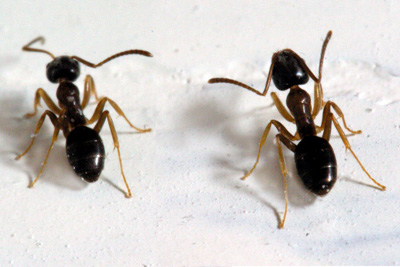Odorous House Ant
Category: Ants

Facts about Odorous House Ants, "Scientific name of Odorous House Ants is Tapinoma sessile". Odorous House Ants are species of ant that go by the common names Odorous ant, Coconut ant, and stick ant.
Their colonies are polygynous (having multiple reproducing queens) and polydomous (consisting of multiple nests). Like many other insects, Odorous House Ants employs a complex foraging strategy, engages in competition with other species of insects, allocates food depending on the environmental conditions, and take the nuptial flight.
The word “Sessile†mean "sitting" which refers to the way the gaster portion of the abdomen sits directly on top of the petiole in the abdomen of the Odorous House Ants. The common names “coconut antâ€, “odorous ant†and "stink ant" come from the smell the Odorous House Ants produce especially when crushed, which is very similar to the smell of a coconut, turpentine, or bleu cheese.
The Odorous House Ants forage mainly for honeydews, floral nectars, and other sugary foods. Honeydew is produced by aphids and other scale insects that are guarded and tended to by the ants. The Odorous House Ants also feed on other small insects.
Odorous House Ants are brown to black in color, and measure between 1/16 and 1/8 inches (1.5 and 3.2 mm) in length. Their antennae have 12 segments. The lifespan of the Odorous House Ants is not well known, but it is approximated that the queen can live for up to 8 months or a little longer than that, workers live for up to 1 or 2 months lesser than the queen’s, while the males appear to have a short lifespan of approximately a week. The males live shorter because they engage frequent battles.
Odorous House Ants are regarded as one of the toughest ants. Observations on injured workers have shown that the Odorous House Ants can continue working for long with little hindrance. Queen Odorous House Ants with crushed abdomens can also continue laying eggs, and some documented instances of the Odorous queens show queen ants surviving without food and water for over 2 months. Unlike many ant species, the Odorous House Ants also appear highly tolerant to cold and heat.
Odorous House Ants foragers collect foods that are around the nesting area and bring them back to the colony to share with others. Odorous ants have polydomous colonies (one colony has multiple nests). This makes the Odorous House Ants to be good at foraging for food when there is a large variance in the distribution of food. Instead of going back to a faraway nest to deliver the food, the Odorous House Ants foragers move the queens, brood and workers to be closer to the food to reduce food transport cost - a method referred to as "dispersed central-place foraging". The nest half-life is about 12.9 days.
The way Odorous House Ants communicate is by using chemicals called (pheromones) they can alert other ants where food and also if danger is coming.
The Queen Odorous House Ants only job in life is to lay 1000 of eggs in their life time. All worker, soldier and queen Odorous House Ants are female. The worker Odorous House Ants, that you see running around, the wingless ants are females that don't reproduce, these are the Odorous House Ants that hunt for food and take care for the queen's offspring, protect the community and work on the nest and other community duties.
The male Odorous House Ants usually have only one role in life, mating with the queen and after they have performed their duty, they can die.
Odorous House Ants are scavengers and predators that can eat most foods homes, especially the sugary ones, as well as other insects. Outdoors the ants will colonize exposed soil and under rocks and. The Odorous House Ants tend to form colonies almost everywhere and in a range of conditions. Indoors the Odorous House Ants tend colonize near insulation and heat sources. During hot and dry conditions, the ants nests have been commonly found in home plants and sometimes in the toilet lids. The Odorous House Ants appears to be more likely to invade homes after rain; probably because the rains wash away the honeydews they collect.
There are more than 20,000, Ant species around the world, there have been 12,500 that have been classified in specific species.
Ants can lift and carry three times their weight.
Odorous House Ants are omnivores, (definition-they eat both other animals and plants).
Odorous House Ants have two stomachs, one that holds food for them to eat and one for other the colony.
You can find Ants on every continent accept Antarctica.
Ants can survive around a full day underwater.

 Back To Category Ants
Back To Category Ants